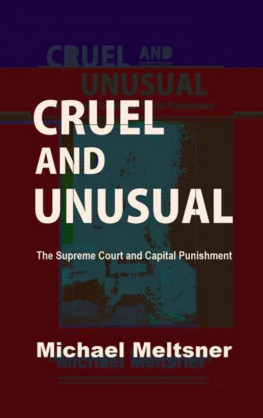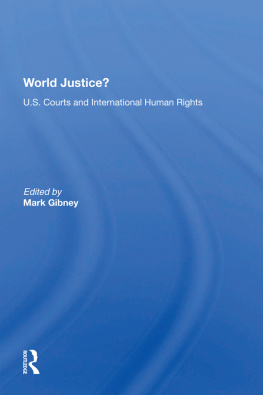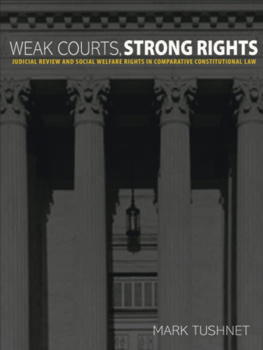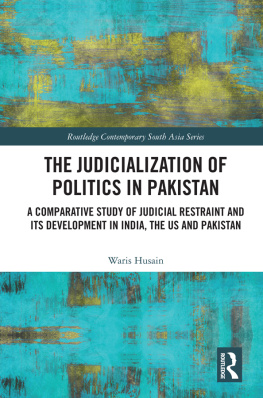The University of Chicago Press, Chicago 60637
The University of Chicago Press, Ltd., London
1998 by The University of Chicago
All rights reserved. Published 1998
14 13 12 11 10 09 08 4 5 6 7
ISBN: 0-226-21161-4 (cloth)
ISBN: 0-226-21162-2 (paperback)
ISBN: 978-0-226-77242-4 (ebook)
Library of Congress Cataloging-in-Publication Data
Epp, Charles R.
The rights revolution : lawyers, activists, and supreme courts in comparative perspective / Charles R. Epp.
p. cm.
Includes bibliographical references and index.
ISBN 0-226-21161-4 (cloth : alk. paper).ISBN 0-226-21162-2 (paper : alk. paper)
1. Civil rightsHistory. I. Title.
K3240.4.E65 1998
342.085dc21
98-14170
CIP

The paper used in this publication meets the minimum requirements of the American National Standard for Information SciencesPermanence of Paper for Printed Library Materials, ANSI Z39.48-1992.
ACKNOWLEDGMENTS
A comparative project of this scope depends on the support of many institutions and people. Foremost, I am deeply indebted to Joel Grossman and Herbert Kritzer for their encouragement, advice, comments, and critiques. Joel directed the dissertation from which this book evolved, and his generous support and encouragement over the course of many years made the project possible. He prodded me, in particular, to develop and refine the idea of a support structure. Bert, too, actively supported and encouraged my research and writing in big and little ways. His advice for conducting research in Britain aided my work there, and his wonderful course on qualitative research methods inspired my comparative research design. In addition, Don Downs, Marc Galanter, and Graham Wilson, my other advisers at the University of Wisconsin, offered very helpful suggestions and criticisms, and Marcs advice regarding India and his contacts there proved essential for the research conducted in that country. I am also grateful to Gerald Rosenberg and Peter Russell for offering many helpful comments and suggestions on the manuscript. I thank Gerald Rosenberg, in particular, for generously offering advice and encouragement that went beyond the usual responsibilities of a manuscript reviewer.
I am also indebted to a number of other people for many helpful comments and contributions at various stages of the project. Richard Pacelle generously allowed access to his data on the U.S. Supreme Courts agenda. Ted Morton, Ian Brodie, and Shannon Ishiyama Smithey provided comments and suggestions that strengthened my treatment of the Canadian case; I am especially grateful to Ted Morton for his generous contributions. Jim Christoph, Carol Harlow, and Susan Sterett provided comments and suggestions that improved my discussion of the British case. For other comments and contributions, I am indebted to Burt Atkins, Jeff Ayres, W. A. Bogart, Ruth Buchanan, Chris Burke, Dana Chabot, Cornell Clayton, Freddie Diamant, Tim Epp, John Esser, Don Farole, Roy Flemming, Todd Foglesong, Robert Geyer, Micheal Giles, Howard Gillman, Stacie Haynie, J. Woodford Howard, Jeff Isaac, Dan Levin, Steven Maynard-Moody John Sayer, Sigrun Skogly, the obstreperous Daniel A. Smith, Mark Suchman, Neal Tate, Tracy Wahl, Jerold Waltman, Stephen Wasby, and Gerald Wright. My colleagues at Indiana University and the University of Kansas, in particular, offered congenial atmospheres for completing the analysis and writing.
Undoubtedly some of the people to whom I am indebted will disagree with parts of my analysis. Their comments and suggestions in the context of disagreement provide a model of the scholarly community, and I can only hope to be as fortunate in the future. Any remaining errors of fact or interpretation are, of course, mine.
My research in Britain, Canada, and India would not have been possible without the advice and support of many people and several institutions in those countries. In India, Rajeev Dhavan generously provided invaluable support, advice, and contacts; the Indian Law Institute provided access to research sources; and the staff in the Office of the Registrar, Supreme Court of India, answered many questions and generously provided access to statistical sources. In Britain, the Institute for Advanced Legal Studies provided a research base for several months, and the staff of the House of Lords Records Office kindly provided access to useful sources. In Canada, the Human Rights Research and Education Centre and the Fauteaux Hall Law Library, both at the University of Ottawa, and the library of the Supreme Court of Canada offered access to many documentary sources. Additionally, many individuals in each of these countries generously consented to interviews, and many rights-advocacy organizations allowed access to their files. I am humbled by the generous and patient guidance and support of my hosts in these countries.
The research for this book depended on financial support from several institutions. The University of Wisconsin, Madison, was a congenial and supportive home for interdisciplinary research on law, and I am grateful in particular for a Legal Studies Fellowship from the Institute for Legal Studies and a dissertation fellowship from the university. My work on this project was made possible as well by a Canadian Government research grant, a National Science Foundation grant (No. SES 9225087), and a summer faculty fellowship from Indiana University.
In the final stages of the process, this book has benefited from the careful and attentive efforts of several people at the University of Chicago Press. In particular, I am grateful to John Tryneski for intelligent and conscientious direction and to Leslie Keros for patient and helpful coordination. And I am indebted to Becky Laurent for unusually perceptive and constructive editing on matters of both style and substance.
I am grateful to the American Political Science Association for permission to incorporate material from my article, Do Bills of Rights Matter? The Canadian Charter of Rights and Freedoms, American Political Science Review 90:76579 (1996), into .
In the end, though, I am especially indebted to my wife, Lora Jost, for her support and ever-sharp critics eye, both of which helped me to maintain this course over what has now been, I realize, a long time. And I dedicate this book to my parents, whose efforts on behalf of human rights have made a difference.
ONE
Introduction
Sed quis custodiet ipsos custodes? (But who will guard the guardians?)
Juvenal
On October 29, 1958, at 5:45 in the morning, nine Chicago police officers acting without a warrant forced their way into James and Flossie Monroes home, pulled the Monroes and their six children out of bed, and forced them to stand half-naked in the living room while they ransacked the home, dumped out the contents of drawers, tore clothes out of closets, and slit open mattresses. Officer Pape, the leader, beat James Monroe with his flashlight and called him nigger and black boy; another officer pushed Flossie Monroe; and several officers kicked and hit the children and pushed them to the floor. The officers eventually took Mr. Monroe to a station house, where he was forced to appear in a lineup and was questioned for ten hours about a recent murder. Throughout the ordeal, the officers refused to allow Monroe to call a lawyer or his family. In the end he was releasedthe victim of a story about a Negro robber concocted by the real murderers. The Monroe family sued the officers under a federal civil rights statute, but the federal district court and the court of appeals rejected their right to sue in federal court. In 1961, to the surprise of many, the United States Supreme Court reversed and granted them this right.
 The paper used in this publication meets the minimum requirements of the American National Standard for Information SciencesPermanence of Paper for Printed Library Materials, ANSI Z39.48-1992.
The paper used in this publication meets the minimum requirements of the American National Standard for Information SciencesPermanence of Paper for Printed Library Materials, ANSI Z39.48-1992.








